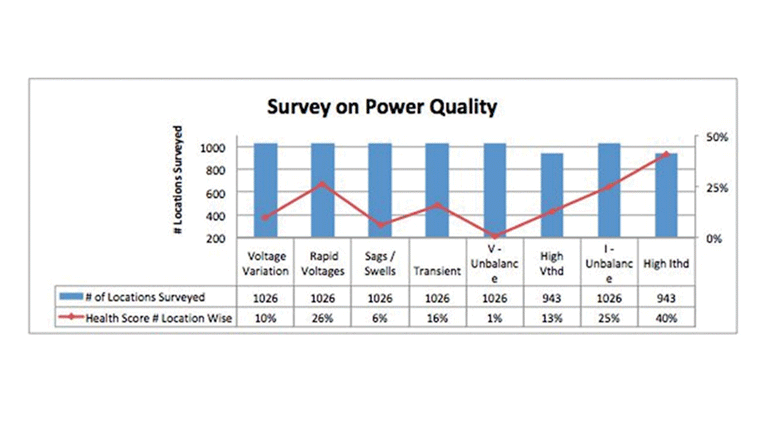Towards cost savings, better incentives and near-zero penalties in your electricity bills!
By EPR Magazine Editorial November 18, 2019 1:58 pm IST
By EPR Magazine Editorial November 18, 2019 1:58 pm IST

Various case studies indicate that industries can save anywhere upto 10 per cent on their electricity bills just by reducing harmonics in their electrical network and improving the power factor. Given the high instances of harmonics and other power quality issues such as voltage sags, low true power factor companies consciously or unintentionally keep on paying higher energy bills and experience lost productivity.
At times, even after remedial measures such as installation of capacitor banks etc. facilities continue to experience these poor power quality issues and thus end up paying energy bills that are higher than anticipated.
Secqr® shows the way
Typically, analysing Harmonics and understanding poor power factor involves several challenges. Among them, the quantification of the losses attributable to these amongst a host of other losses that occur, and the calculations required to arrive at the optimum mitigation solutions; are some of the more difficult ones to solve.
Designed by experts with years of on-field experience and research, Secqr® is India’s first online tool for Harmonics and power factor assessment. Particularly, Secqr® provides practical answers to seven key questions that are important to understand and achieve the potential savings through power factor improvement and Harmonic reduction.
“Towards greater cost savings, better incentives and near-zero penalties in your electricity bills!”
How can you save on energy costs, incurred due to harmonics?
Almost always a black box in terms of benefits accrued, when it comes to Harmonic filters. For the first time you have a simplified self assessment with the tool to understand the estimated energy reduction due to harmonic mitigation. Further, the tool also provides facilities in different states with varying energy billing to take advantage. For instance; a state where KVAh billing is in practice, will get their savings automatically thrown based on the KVAh losses that are incurred and similarly for KWh.
How much KVAR should you install to reach optimum PF?
For the first time, you will get a completely neutral view on knowing how much KVAR is required to optimise power factor, in line with the facilities’ state specific tariff structures. For example, a facility in West Bengal is required to maintain a near unity power factor, since the tariff structure there incentivises approximately 7 per cent of the energy bill, whereas Tamil Nadu does not require unity power factor. Similarly, a state where KVAh billing is in practice would not have any incentives or penalties for maintaining power factor but all the more important ones; since the facility unwittingly pays for the complete line losses due to a poor power factor by high energy bill which generally go unnoticed. Trust Secqr®, to understand your reactive power compensation requirements and suggest optimum intervention.
How to check if you have compliance as per latest IEEE 519-2014 standards?
Standards can be difficult to test and implement with limited toolset and skills available on the field. The tool empowers your team and makes it easy and quick to check estimated compliance to IEEE 519-2014 standards, which are very soon expected to be rolled out pan India based on the CERC’s model PQ regulations.
What are your cable and transformer losses due to harmonics?
Harmonics is a hidden menace, often, difficult to detect and diagnose. The tool, with its ability to perform complex calculations, helps you to understand the magnitude of cable and transformer losses which you are incurring every minute due to harmonics and provides easy to understand bifurcation of the same prorated annually.
How do you fix the budget for harmonic mitigation and PF improvement?
Often difficult to fix, due to varying configurations and topologies of harmonic and PF improvement solutions, get a simplified measure of what is needed, and a benchmarked budget on the solution proposed along with an estimated ROI too! Of course there will be those where none of the investments in harmonic mitigation / PF improvement is warranted; and thus will save a lot of facilities, unnecessary time, effort and money to go through such a fact finding exercise.
What can be your estimated harmonic distortion even if you do not have harmonic measurements available?
In cases where either measurement for harmonics is not available, or simply it is a green field project, the tool will allow a quick glance at what could be the projected harmonic distortions that are expected based on the type of loads which can be selected. Thus, it gives you an estimated picture based on which further measurements, if possible, can be planned for further fine tuning or mitigation strategies planned for green field projects.
In its goal to build awareness and penetration of the perilous effects that Power Quality (PQ) imposes on consumers across industrial, commercial and institutional facilities, Asia Power Quality Initiative (APQI – www.apqi.org) in collaboration with its National Support Network (NSN) partner Efficienergi, has launched Secqr® (https://secqr.efficienergi.com) to make it easy and convenient to assess the ill-effects of poor power factor and high harmonics on discerning facilities.
Author by
Rajen Mehta,CEO,Efficienergi Consulting Pvt. Ltd.
We use cookies to personalize your experience. By continuing to visit this website you agree to our Terms & Conditions, Privacy Policy and Cookie Policy.